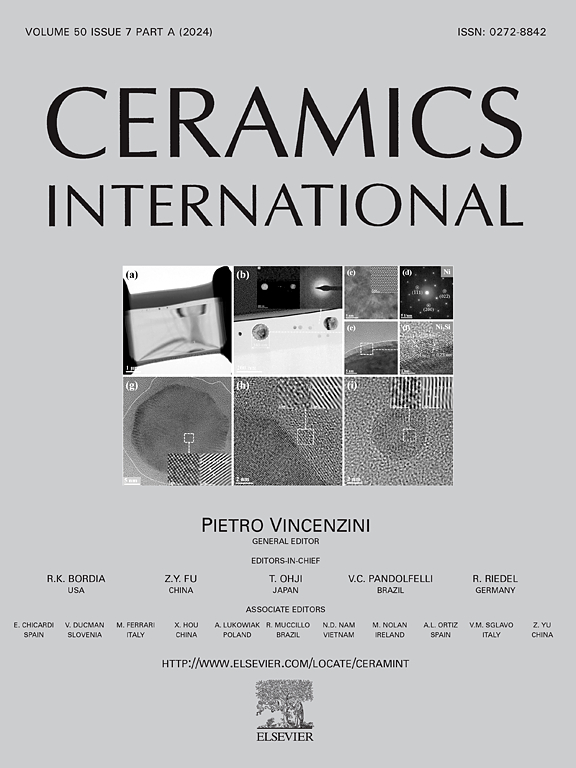Li+共掺杂GdPO4·H2O:Tb3+,Ce3+绿色荧光粉的光致发光和能量转移增强
IF 5.1
2区 材料科学
Q1 MATERIALS SCIENCE, CERAMICS
引用次数: 0
摘要
采用水热法制备了一系列发光可调的gd0.85 - xtb0.15 . po4·H2O:xCe3+ (x = 0-0.06)和gd0.80 - ytb0.15 . ce0.05 . po4·H2O:yLi+ (y = 0.01-0.06)荧光粉。采用XRD、SEM、EDS、FT-IR和PL分别表征了样品的相结构、形貌、元素组成、表面吸收和发光性能。结果表明,所合成的样品均为纯六方相结构的GdPO4·H2O纳米棒。研究了Ce3+和Li+浓度对Li+共掺杂GdPO4·H2O:Tb3+、Ce3+绿色荧光粉光致发光性能的影响。当Ce3+和Li+离子共掺杂到GdPO4·H2O:Tb3+中时,激发带从274 nm红移到302 nm,并且由于在GdPO4·H2O中Ce3+→Tb3+的高效能量转移,发射强度比Ce3+/Li+自由Gd0.85Tb0.15PO4·H2O提高了约30倍。优化后的Gd0.76Tb0.15Ce0.05PO4·H2O:0.04Li+荧光粉的内量子效率为25.94%,热稳定性为162.9% @473 K。为了提高GdPO4·H2O:Tb3+,Ce3+绿色荧光粉的结晶度和发光强度,提出了一种新的设计策略,即通过Li+共掺杂诱导助熔剂或敏化剂。这些结果表明,由于GdPO4·H2O:Tb3+,Ce3+,Li+荧光粉在紫外区具有较宽的激发带和较强的绿色发光,因此作为w- led的紫外转换荧光粉具有很好的应用前景。本文章由计算机程序翻译,如有差异,请以英文原文为准。

Enhanced photoluminescence and energy transfer of Li+ co-doped GdPO4·H2O:Tb3+,Ce3+ green phosphors
A series of luminescent emission-tunable Gd0.85-xTb0.15PO4·H2O:xCe3+ (x = 0–0.06) and Gd0.80-yTb0.15Ce0.05PO4·H2O:yLi+ (y = 0.01–0.06) phosphors have been successfully synthesized via hydrothermal method. The phase structure, morphology, elemental composition, surface absorption and luminescence properties of the samples were characterized by XRD, SEM, EDS, FT-IR and PL, respectively. The results show that all the synthesized samples are all pure hexagonal phase structure of GdPO4·H2O nanorods. The influence of Ce3+ and Li+ concentrations on the photoluminescence properties of the Li+ co-doped GdPO4·H2O:Tb3+,Ce3+ green phosphors have been thoroughly investigated. When Ce3+ and Li+ ions were co-doped into GdPO4·H2O:Tb3+, the excitation band red-shifted from 274 to 302 nm, and the emission intensity was enhanced up to approximately 30 times compared with that of Ce3+/Li+-free Gd0.85Tb0.15PO4·H2O because of the efficient energy transfer from Ce3+→Tb3+ in the GdPO4·H2O host. Moreover, the optimized Gd0.76Tb0.15Ce0.05PO4·H2O:0.04Li+ phosphor has an internal quantum efficiency of 25.94 % and exhibits superior thermal stability (162.9 %@473 K). A new design strategy was proposed to enhance the crystallinity and luminescence intensity of GdPO4·H2O:Tb3+,Ce3+ green phosphor by inducing a flux or sensitizer through Li+ co-doping. These results indicate that the GdPO4·H2O:Tb3+,Ce3+,Li+ phosphor hold promising potential application as a UV-convertible phosphor for w-LEDs due to its wide excitation band in the ultraviolet region and effective generation of strong green emission.
求助全文
通过发布文献求助,成功后即可免费获取论文全文。
去求助
来源期刊

Ceramics International
工程技术-材料科学:硅酸盐
CiteScore
9.40
自引率
15.40%
发文量
4558
审稿时长
25 days
期刊介绍:
Ceramics International covers the science of advanced ceramic materials. The journal encourages contributions that demonstrate how an understanding of the basic chemical and physical phenomena may direct materials design and stimulate ideas for new or improved processing techniques, in order to obtain materials with desired structural features and properties.
Ceramics International covers oxide and non-oxide ceramics, functional glasses, glass ceramics, amorphous inorganic non-metallic materials (and their combinations with metal and organic materials), in the form of particulates, dense or porous bodies, thin/thick films and laminated, graded and composite structures. Process related topics such as ceramic-ceramic joints or joining ceramics with dissimilar materials, as well as surface finishing and conditioning are also covered. Besides traditional processing techniques, manufacturing routes of interest include innovative procedures benefiting from externally applied stresses, electromagnetic fields and energetic beams, as well as top-down and self-assembly nanotechnology approaches. In addition, the journal welcomes submissions on bio-inspired and bio-enabled materials designs, experimentally validated multi scale modelling and simulation for materials design, and the use of the most advanced chemical and physical characterization techniques of structure, properties and behaviour.
Technologically relevant low-dimensional systems are a particular focus of Ceramics International. These include 0, 1 and 2-D nanomaterials (also covering CNTs, graphene and related materials, and diamond-like carbons), their nanocomposites, as well as nano-hybrids and hierarchical multifunctional nanostructures that might integrate molecular, biological and electronic components.
 求助内容:
求助内容: 应助结果提醒方式:
应助结果提醒方式:


